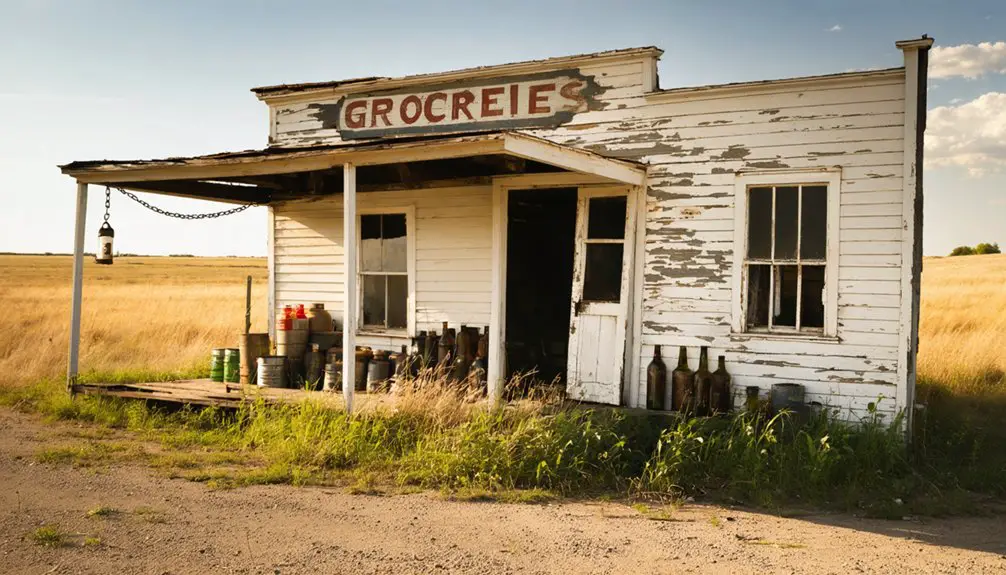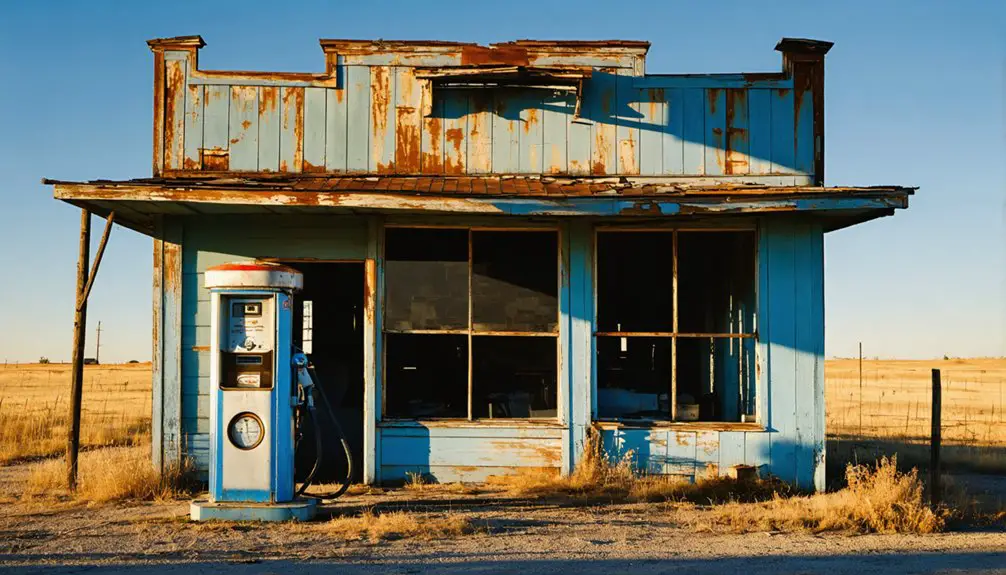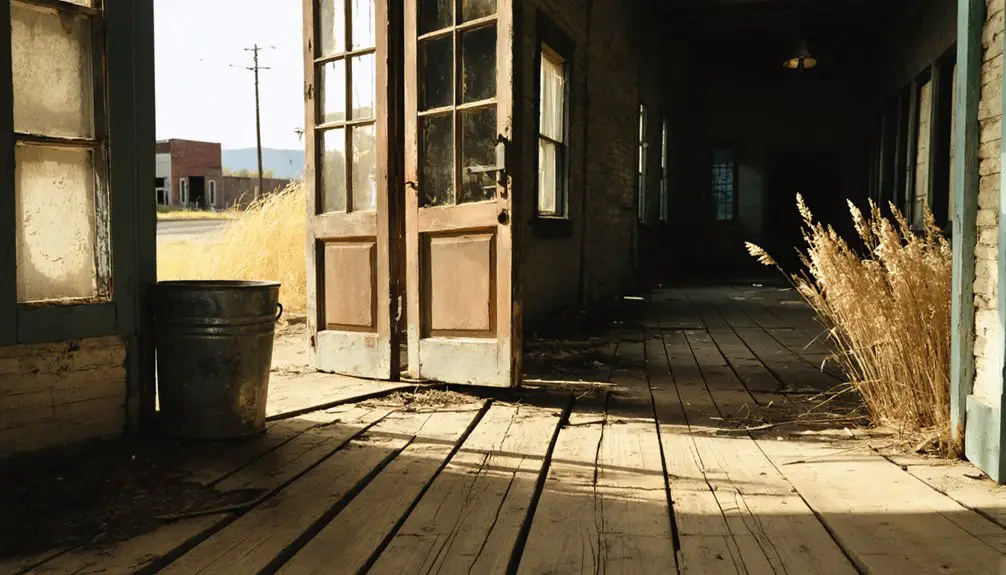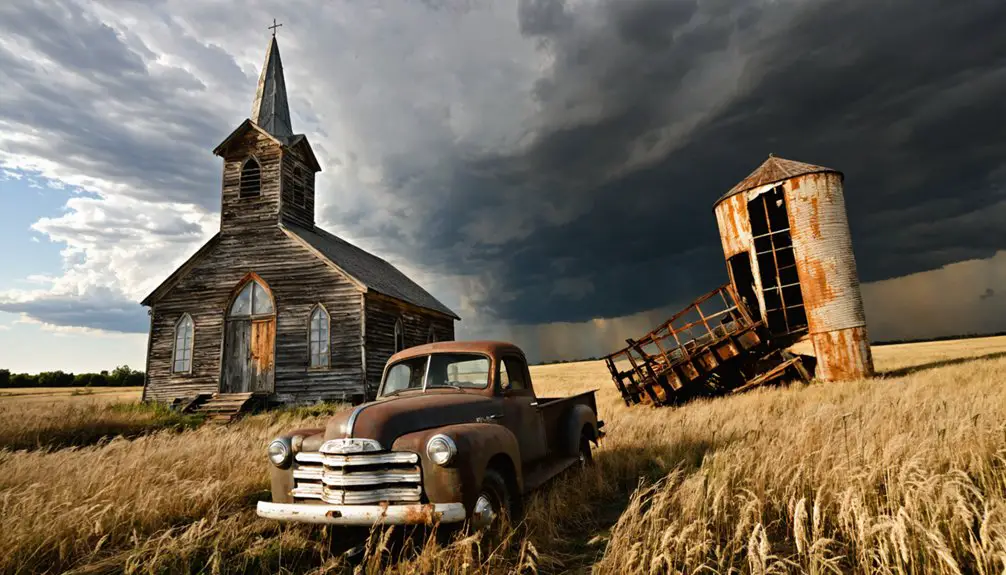You’ll find Cooperton’s ghost town remains fourteen miles south of Gotebo, Oklahoma, where Frank Cooper’s 1899 settlement once thrived with 187 residents. After failing to secure a crucial railroad connection in the 1920s, this frontier community declined from its peak, losing its bank, cotton gin, and most businesses. Today, just three residents live among abandoned buildings, including a weathered 1927 bank and old service station – silent witnesses to the town’s vanished dreams.
Key Takeaways
- Cooperton, Oklahoma declined from 187 residents in 1940 to just 3 residents in 2020, becoming a ghost town in Kiowa County.
- The town’s failure to secure railroad connections in the 1920s led directly to its economic decline and eventual abandonment.
- Abandoned buildings include a 1927 bank, weathered service station, and old store, with vintage cars adding to the ghost town atmosphere.
- Originally named Cooper, the settlement was established in 1899 by Frank Cooper but relocated due to a land registration error.
- All but one church have closed, with eighteen businesses from the 1940s now gone, leaving mostly vacant and deteriorating structures.
The Birth of a Prairie Settlement
As the Kiowa, Comanche, and Apache Reservation prepared to open for settlement in 1901, Frank Cooper strategically established a settlement company to secure land near the Wichita Mountains in what would become Cooperton, Oklahoma.
You’ll find that settlement challenges emerged when the government switched from a land run to a land lottery system, forcing Cooper to adapt his plans. His company secured 320 acres, though not where they’d initially hoped. Much like the Land Run of 1889, thousands of hopeful settlers sought their piece of Oklahoma Territory.
Settlement plans had to pivot when the lottery replaced the land run, leading Cooper’s company to claim different acreage than intended.
A townsite registration error prompted relocation to Cooperton’s current location, about fourteen miles south of Gotebo and nine miles east of Roosevelt.
Despite these setbacks, the town quickly developed into a bustling prairie community, complete with eighteen businesses including stores, hotels, and essential services that would serve the area’s new residents. The town’s steady growth was evident as the population reached 100 by 1910.
From Cooper to Cooperton: A Name’s Evolution
When you look back at the original 1899 settlement, you’ll find it was called Cooper, honoring Captain Frank Cooper who organized the initial settlement company near the geological divide between the Slick Hills and Wichita Mountains. Like many early settlements in the state, it was established during the period of major land rushes that opened tribal territories to white settlers.
The planned location at the foot of the Wichita Mountains ended up being two miles east of where Cooperton stands today, due to an error in registering the townsite.
The name change to Cooperton became necessary because another community named Cooper already existed in present-day Blaine County, Oklahoma, prompting the addition of “-ton” to create a unique identifier while preserving the founder’s name. The community saw its peak of 187 residents in 1940, marking the height of its population before a steady decline began.
Original Cooper Settlement
The original Cooper settlement emerged in 1899 through the vision of Frank Cooper, who strategically organized a settlement company in anticipation of the 1901 Kiowa, Comanche, and Apache Reservation opening.
After learning land would be allocated by lottery rather than a run, Cooper’s founder’s vision secured 320 acres near the Wichita Mountains for his company members, about two miles east of present-day Cooperton.
Despite settlement challenges, including a registration error with the townsite’s location, Cooper’s planned community took shape in Oklahoma Territory.
The Comanche and Kiowa tribes had migrated to these Southern Plains in the early 18th century before the settlement was established.
Archaeological evidence at the site includes mammoth remains dating back 18,000 years, indicating a rich prehistoric presence in the area.
You’ll find the settlement reflected the broader historical context of Native American land transfers and treaties.
The site’s position in Kiowa County proved attractive for farming and ranching, though initial confusion over the exact location would later impact the town’s development.
Cooperton Name Change Necessity
Shortly after establishing the original settlement, Frank Cooper’s planned community faced an unexpected challenge that would reshape its identity.
You’ll find that name confusion emerged when officials discovered another town called Cooper already existed in Blaine County, creating legal implications for mail delivery and land records.
The solution came through adding the suffix “-ton” to Cooper’s name, a common practice in Oklahoma Territory that resolved postal duplications while honoring the founder’s legacy.
This change required re-registration of the townsite and revision of government documents, aligning with Oklahoma’s post-1901 land lottery regulations that distributed over 2 million acres from tribal lands.
The modification proved beneficial, as Cooperton’s distinct identity helped foster community growth near the Wichita Mountains in Kiowa County, reaching 100 residents by 1910.
Early Business and Community Life
During Cooperton’s early development, five essential businesses formed the commercial heart of this Oklahoma settlement: two general stores, a post office, a livery stable, and a drug store.
Local commerce flourished as these establishments served ranchers and farmers, while a bank provided crucial financial services. You’d find a hardware store supplying tools, a cotton gin processing crops, and a blacksmith keeping equipment in working order. Like other communities near whiskey towns, Cooperton maintained strict regulations on alcohol-related businesses.
Community engagement thrived through the town’s newspaper, the Cooperton Banner, while two hotels welcomed visitors to this bustling settlement.
The cigar factory and mill added to the town’s manufacturing base. Churches and schools strengthened social bonds, and a town board governed local affairs. Today, only few residences remain from this once-thriving community.
The Missing Railroad Connection
While businesses and community life flourished in early Cooperton, a critical piece of infrastructure remained notably absent. The town’s railroad expectations centered on the Lawton, Wichita Falls and Northwestern Railway’s ambitious plan to connect Lawton to Wichita Falls.
Despite issuing $800,000 in bonds by 1908, the company’s efforts failed before laying a single rail. The city of Lawton, Oklahoma would remain a key transportation hub while Cooperton struggled.
The economic impact of this missing connection proved devastating. You’ll find that while other Oklahoma towns thrived with rail access, Cooperton struggled to reach broader markets.
Even when the Wichita Falls and Oklahoma Railway built a nearby line in 1922, it bypassed Cooperton and was abandoned by 1942.
Without rail transport, the town’s population plummeted from 187 in 1940 to just 3 in 2020, leaving Cooperton dependent on Highway 54/19 for survival.
Peak Years and Population Growth

Despite lacking rail transportation, Cooperton experienced steady growth after Frank Cooper’s initial 1899 settlement plan, reaching approximately 100 residents by 1910. The settlement dynamics reflected careful planning, with 320 acres secured for community development ahead of the 1901 reservation opening lottery.
You’ll find the population trends reached their pinnacle in 1940 with 187 residents, when the town boasted 18 businesses including general stores, a bank, cotton gin, and cigar factory. The Cooperton Banner newspaper and an organized town board served the thriving community.
However, the town’s liveliness wouldn’t last. After 1940, Cooperton faced steady decline, dropping to 106 residents by 1960. The downward spiral continued, reaching just 3 residents by 2020, marking a dramatic transformation from bustling rural hub to near ghost town status.
The Long Decline: 1940-2020
You’ll find Cooperton’s stark population decline began after its 1940 peak of 187 residents, steadily dropping to just 20 people by 2000 and a mere three inhabitants by 2020.
The exodus coincided with the systematic closure of essential community services, as the town lost its school, bank, general stores, and service stations.
The transformation from family farms to corporate agricultural operations further accelerated the community’s dissolution, leaving abandoned buildings as silent witnesses to Cooperton’s vanishing population.
Population Exodus Details
As Cooperton entered the 1940s with its peak population of 187 residents, the town’s gradual descent into near-abandonment began to unfold.
You’d have witnessed dramatic population dynamics as the numbers plummeted by 31% in just one decade, dropping to 129 by 1950.
The rural migration intensified through the following decades, with the population halving to 55 by 1970 and further declining to 31 by 1980.
By 1990, only 15 residents remained, though a brief uptick brought it to 20 in 2000.
The most devastating exodus occurred between 2010 and 2020, when the population collapsed from 16 to just 3 residents.
The town’s aging demographics and lack of economic opportunities have left Cooperton teetering on the edge of complete abandonment.
Community Services Disappear
When Cooperton entered the 1940s with its bustling array of 18 businesses, few residents could have predicted the devastating erosion of community services that would unfold over the next eight decades.
You’d have witnessed the town’s civic engagement crumble as essential services vanished one by one – the schools closed and consolidated with neighboring towns, while the bank, drug store, and cotton gin shut their doors permanently.
The absence of a railroad and bypass by major highways sealed the town’s fate. Despite attempts at community resilience, only one church remains active today, serving as a lone reminder of Cooperton’s vibrant past.
Infrastructure deteriorated as the tax base shrank, and municipal services dwindled, transforming this once-thriving community into a shadow of its former self.
Abandoned Buildings and Remnants

Throughout Cooperton’s abandoned landscape, numerous buildings stand as silent witnesses to the town’s decline, including a weathered service station, an old store, and a bank with its 1927-dated door.
These brick and wooden structures, typical of early 1900s rural architecture, now battle against nature’s persistent advance. You’ll find boarded windows, collapsed roofs, and interiors exposed to Oklahoma’s harsh elements, while aggressive vegetation steadily reclaims the town’s footprint.
Near the service station, you’ll spot a collection of vintage cars slowly rusting away, adding to the scene of rural decay.
The absence of residential buildings tells its own story – as small farms were absorbed into larger corporate operations, Cooperton’s community gradually disappeared, leaving these commercial remnants as the last tangible links to its past.
Oklahoma’s Ghost Town Legacy
Oklahoma’s rich legacy of ghost towns, numbering around two thousand sites statewide, tells a complex story of boom-and-bust cycles tied to mining, oil, and liquor economies.
The ghost town significance extends beyond mere abandoned buildings, reflecting the state’s dynamic economic fluctuations and cultural shifts.
- You’ll find Pushmataha County holds the highest concentration, with 13 documented ghost towns.
- Railroad decisions often determined a town’s fate, with bypassed communities facing swift decline.
- Towns like Beer City flourished until statehood in 1907 brought prohibition.
- Environmental factors shaped destinies, as seen in Picher’s toxic contamination.
- Some towns, like Keystone and Appalachia, now rest beneath reservoir waters, submerged by 1960s dam construction.
These abandoned places span from pre-statehood to 2010, marking distinct chapters in Oklahoma’s frontier heritage.
A Window Into Rural Settlement History

The planned settlement of Cooperton in 1899 offers a fascinating window into early Oklahoma Territory’s change from open rangeland to organized communities.
You’ll find Cooperton’s story reflects the settlement challenges faced by countless frontier towns, as Frank Cooper’s settlement company secured 320 acres through a lottery rather than the typical land run system. The town’s location near the Wichita Mountains initially promised prosperity through agricultural reliance, with a diverse mix of businesses serving local farmers and ranchers.
Yet Cooperton’s trajectory reveals how critical factors like railroad access could make or break a community’s future.
Towns lived or died by the iron horse – a truth that shaped Cooperton’s fate like countless frontier communities.
From its peak of 187 residents in 1940 to just three people by 2020, you’re witnessing a common pattern of rural decline that shaped Oklahoma’s landscape throughout the 20th century.
Frequently Asked Questions
Are Any Original Resident Families Still Living in Cooperton Today?
You won’t find any original families or local descendants living in Cooperton today. Historical records show all founding residents gradually left over decades, with only three unrelated inhabitants remaining by 2020.
What Happened to the Cooperton Banner Newspaper Archives?
Like scattered seeds in prairie winds, the Cooperton Banner’s archives vanished with time. You won’t find complete collections digitally or on microfilm – they’re likely lost to history’s decay.
Can Visitors Legally Explore the Abandoned Buildings in Cooperton?
You can’t legally explore Cooperton’s abandoned buildings without property owner permission due to legal restrictions. Follow visitor guidelines by seeking authorization first and respecting private property boundaries to avoid trespassing charges.
Did Any Notable Historical Events or People Originate From Cooperton?
You won’t find any notable events or widely recognized historical figures from Cooperton. While Frank Cooper founded the town, and Thomas Sterling was an early resident, neither achieved broader historical significance.
Are There Any Efforts to Preserve or Restore Cooperton’s Historical Structures?
You’ll find community-led historical preservation focused on repurposing the rock school building into a community center, while biennial reunions help maintain local heritage. However, without government-sponsored restoration efforts, many structures face decay.
References
- https://www.okhistory.org/publications/enc/entry?entry=CO055
- https://en.wikipedia.org/wiki/List_of_ghost_towns_in_Oklahoma
- https://www.okhistory.org/publications/enc/entry?entry=GH002
- https://www.youtube.com/watch?v=FBOZkDBpSTs
- https://abandonedok.com/class/disappearing-town/
- https://en.wikipedia.org/wiki/Oklahoma_Territory
- https://www.okhistory.org/publications/enc/entry?entry=SE024
- https://en.wikipedia.org/wiki/History_of_Oklahoma
- https://www.connerprairie.org/wp-content/uploads/2023/09/Transcript-Season-2-Episode-3-Chief-Straw.docx
- https://en.wikipedia.org/wiki/Cooperton



